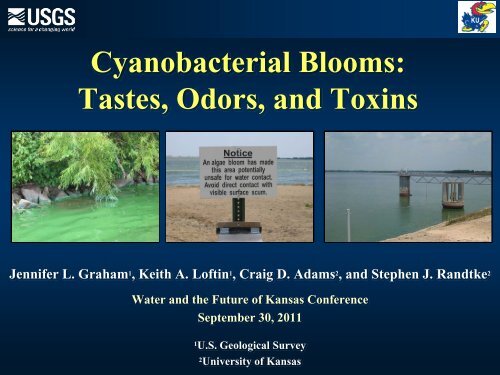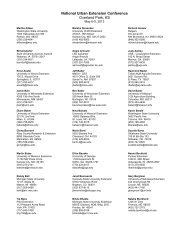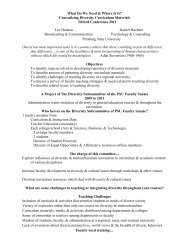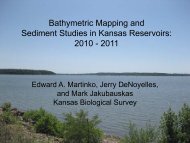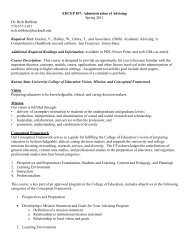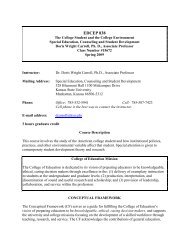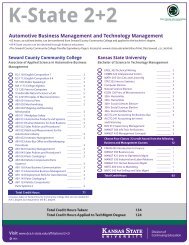Cyanobacterial blooms
Cyanobacterial blooms
Cyanobacterial blooms
Create successful ePaper yourself
Turn your PDF publications into a flip-book with our unique Google optimized e-Paper software.
<strong>Cyanobacterial</strong> Harmful Algal Blooms• Ecologic Concerns– Low dissolved oxygen– Fish kills• Economic Concerns– Loss of recreational revenue– Taste and odor• Olfactory sensitivity to taste-andodorsat low concentrations (5-10 ng/L)– Added drinking watertreatment costs• Health Concerns– Toxicity• Cyanotoxins are on the EPAContaminant Candidate ListBinder Lake, IowaMarion Reservoir, Kansas
<strong>Cyanobacterial</strong> Toxins and Taste-and-Odor CompoundsHepatotoxins Neurotoxins Dermatoxins Taste/OdorCYL MC ANA SAX GEOS MIBAnabaena X X X X X X ?Aphanizomenon X ? X X X XMicrocystis X XOscillatoria/Planktothrix X X X X X XAnabaena Aphanizomenon MicrocystisPlanktothrixPhotos courtesy of A. St. AmandAfter Graham and others, 2008
Cyanotoxin ExposureDo not try this at home (or anywhere else)!• Ingestion and inhalationduring recreationalactivities (most likely)− WHO Guideline for microcystin-LR: 20 µg/L• Inhalation of aerosolizedtoxins• Consumption in drinkingwater− WHO Guideline formicrocystin-LR: 1 µg/LGrand Lake St. Marys, OhioSource of Photos Unknown
Cyanotoxin ExposureDo not try this at home (or anywhere else)!• Ingestion and inhalationduring recreationalactivities (most likely)− WHO Guideline for microcystin-LR: 20 µg/L• Inhalation of aerosolizedtoxins• Consumption in drinkingwater− WHO Guideline formicrocystin-LR: 1 µg/LGrand Lake St. Marys, OhioSource of Photos Unknown
OccurrenceMicrocystins Are Common and Widespread in the United States,Particularly in the Midwest33% of lakes had detections (n=1,028)Maximum concentration: 230 µg/LMedian:
OccurrenceMicrocystins are Widespread and Common in the Midwest78% of lakes had detections (n=359)Maximum concentration: 52 µg/LAfter Graham and others 2004, 2006, and 2009
OccurrenceMultiple Toxins and Taste-and-Odor CompoundsFrequently Co-Occur in <strong>Cyanobacterial</strong> Blooms17% of lakes had concentrations > 20 µg/LMaximum concentration by ELISA: 13,000 µg/LAfter Graham and others, 2010
SeasonalitySeasonal Patterns in Microcystin Concentration are Unique to Individual Lakesand Peaks May Occur Anytime Throughout the Year2520151052Marceline 1, MOBilby Ranch, MO1Weatherby Lake, MissouriJanuary, 2007Microcystin (μg/L)21212Harrison, MOMozingo, MOForest, MO12Sterling Price, MOMozingo Lake, MissouriOctober, 20011J F M A M J J A S O N D2004 After Graham and others, 2006
Environmental InfluencesRegional Associations Between Microcystin and EnvironmentalVariables Are Not Linear25Total Microcystin (μg/L)% Microcystin Detection201510500 500 1000 1500 2000 2500 3000 25 3500Total Nitrogen (μg/L)12108642n=100n=431n=438n=20n=297n=66n=38n=7n=1n=420151050Total Microcystin (μg/L)00 1 2 3 4 5 6 7 812n=485% Microcystin Detection1086n=164n=3024n=1662n=115n=63n=51n=22n=11n=6n=5n=4n=2n=2n=1n=10Secchi Depth (m)After Graham and Jones, 2009
Environmental InfluencesSeasonal Patterns and Environmental Influences May BeRelatively Consistent Between Years in Some LakesCheney Reservoir, KS 2001-20092.01.5GeosminMicrocystinCyanobacteriaMedian Normalized Values1.00.50.0-0.5-1.0-1.5-2.0Jan Feb Mar Apr May Jun Jul Aug Sep Oct Nov Dec
Environmental InfluencesPeaks in <strong>Cyanobacterial</strong> Abundance in Cheney Reservoir areAssociated with the Seasonal Minima in Turbidity and NitrateCheney Reservoir, KS 2001-20092.01.5Median Normalized Values1.00.50.0-0.5-1.0-1.5TurbidityNitrateCyanobacteria-2.0Jan Feb Mar Apr May Jun Jul Aug Sep Oct Nov Dec
Environmental InfluencesContinuous Water-Quality Monitors Can Be Used to Develop Models toCompute Geosmin Concentrations in Real TimeCheney Reservoir, KShttp://nrtwq.usgs.gov/ks/
<strong>Cyanobacterial</strong> Harmful Algal Blooms are SpecificallyAddressed in the Kansas Reservoir Roadmap• Understanding the environmentalfactors associated with theoccurrence and concentration oftaste-and-odor compounds andcyanotoxins is key to reservoir andlake management, drinking watertreatment decisions, andminimization of human health risks.• Specific Reservoir RoadmapRecommendations:– Data collection.– Development of reliable means ofpredicting and responding tocyanobacterial <strong>blooms</strong>.– Watershed efforts to reduce sediment(and nutrients) entering reservoirs.Graphic courtesy of theKansas Water Officehttp://www.kwo.org
<strong>Cyanobacterial</strong> Harmful Algal Blooms in Kansas During Summers 2010 and2011 Resulted in Taste-and-Odor and Toxin Concerns in Surface-WaterSupplies Used for Drinking Water, Including the Kansas River
Drinking-Water TreatmentBecause Humans Are Sensitive to Geosmin and MIB at Concentrations of5 to 10 ng/L, Taste and Odor May Be a Problem Even AfterConcentrations Have Been Substantially ReducedConcentration (ng/L)120100806040200PAC Adsorption in a Simulated Solids-Contact ReactorGeosminMIB0 2 4 6 8 10 12 14 16Number of CyclesAfter Pan, 2002
Drinking-Water TreatmentHigh Surface Area PAC Resulted in a Better Removal Rate ofSaxitoxin in Bench-Scale ExperimentsSTX Remaining Percent100101(a)HDBANWPH2 hours 24 hours1 10 100PAC Dose, mg/LSTX Remaining Percent10010(b)1ANWPHHDB1 10 100PAC Dose, mg/LHDB – Bituminous Coal, low surface area PACWPH – Lignite Coal, intermediate surface area PACAN – Wood, high surface area PAC
Drinking-Water TreatmentNot All Oxidants Are Effective at Removing Cyanotoxins and Efficacy VariesDepending on the ToxinPermanganateMonochloramineMicrocystin-LRCylindrospermopsinAfter Chen and others, 2009 and Ding and others, 2010
Conclusions• <strong>Cyanobacterial</strong> <strong>blooms</strong> andassociated toxins and taste-andodorcompounds commonly occurthroughout the United States.• The cyanotoxin microcystin iscommon in the Midwest and mayreach levels that can cause healthconcerns.Okamanpeedan Lake, Minnesota• Much more study is needed todevelop reliable means ofpredicting and responding tocyanobacterial <strong>blooms</strong> to ensurepublic health protection.Binder Lake, Iowa
Additional Information:http://ks.water.usgs.gov/studies/qw/cyanobacteria/http://ceae.engr.ku.edu/jlgraham@usgs.gov785-832-3511


